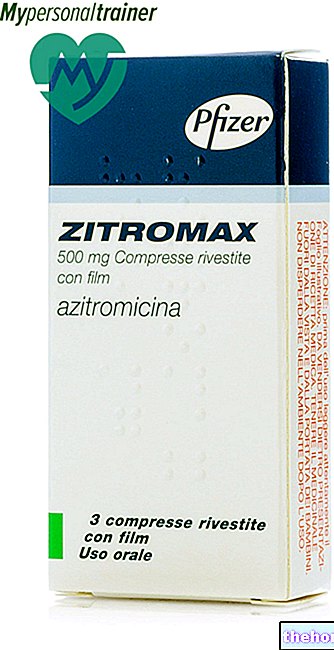Active ingredients: Trifluoperazine
MODALINA 1 mg coated tablets
MODALINA 2 mg coated tablets
Why is Modalina used? What is it for?
PHARMACO-THERAPEUTIC CATEGORY
Antipsychotic.
THERAPEUTIC INDICATIONS
Treatment of the manifestations of psychotic disorders. Control of the states of anxiety, tension and agitation that are observed in neuroses or associated with somatizations.
Contraindications When Modalina should not be used
Hypersensitivity to the active substance or to any of the excipients.
Patients with severe central nervous system depression of iatrogenic origin or other causes.
Blood dyscrasias, bone marrow depressions, liver disease, Parkinson's disease or parkinsonian syndromes
Precautions for use What you need to know before taking Modalina
Since hypotension has also been observed, administration of the drug in high doses should be avoided in patients with diseases of the cardiovascular system.
Since some phenothiazine derivatives have been described to cause retinopathies, treatment with MODALINA should be discontinued if ophthalmoscopic and visual field examination demonstrates retinal changes. Similar behavior should be observed in angina patients who respond poorly to therapy for increased of pain.
With prolonged administration of high doses of the medicinal product, the possibility of a build-up effect with severe vasomotor or central nervous system symptoms should be borne in mind.
To reduce the frequency of these and other side reactions, patients undergoing long-term treatment, especially with high doses of the drug, should be examined periodically in order to verify the possibility of reducing the maintenance dose or discontinuing therapy.
In pregnant women, the product should be administered in cases of real need, under the direct supervision of the doctor. However, the use of MODALINA should be avoided, especially in the first trimester.
Use with caution in patients with cardiovascular disease or a family history of QT prolongation.
Avoid concomitant therapy with other neuroleptics.
If you or someone in your family have a history of thrombosis, these medicines have been associated with thrombus formation.
Interactions Which drugs or foods can modify the effect of Modalina
Tell your doctor or pharmacist if you have recently taken any other medicines, even those without a prescription.
The simultaneous use or subsequent use of sedative drugs, narcotics, anesthetics, tranquilizers or alcohol can determine an undesirable additive enhancement of the antidepressant effect on the Central Nervous System.
The association with other psychotropic drugs requires particular caution and vigilance on the part of the physician to avoid unexpected undesirable effects from interaction.
When neuroleptics are administered concomitantly with QT prolonging drugs, the risk of developing cardiac arrhythmias increases.
Do not administer concomitantly with drugs that cause electrolyte disturbances.
Warnings It is important to know that:
In cases of hypersensitivity to phenothiazine drugs (e.g. blood dyscrasias, jaundice), drugs of this type, including MODALINA, should not be re-administered unless, in the physician's judgment, the potential benefits of treatment outweigh the possible risk.
A potentially fatal symptom complex called Neuroleptic Malignant Syndrome (S.N.M.) has been reported during treatment with antipsychotic drugs. Clinical manifestations of this syndrome are: hyperpyrexia, muscle rigidity, akinesia, vegetative disorders (irregularities in the pulse and blood pressure, sweating, tachycardia, arrhythmias), alterations in the state of consciousness that can progress to stupor and coma. The treatment of the S.N.M. it consists in immediately suspending the administration of antipsychotic drugs and other non-essential drugs and in instituting intensive symptomatic therapy (particular care must be taken to reduce hyperthermia and correct dehydration). If the resumption of antipsychotic treatment is deemed essential, the patient should be carefully monitored.
An approximately three-fold increase in the risk of cerebrovascular events was observed in randomized clinical trials versus placebo in a population of patients with dementia treated with some atypical antipsychotics. The mechanism of this increased risk is unknown. An increased risk for other antipsychotics or other patient populations cannot be excluded. MODALINA should be used with caution in patients with stroke risk factors.
Pregnancy and breastfeeding
Studies on animal reproduction and clinical experience have not so far shown that trifluoperazine is free from teratogenic effects. Therefore, as with any other medicament, MODALINA can only be used in pregnant women if, in the opinion of the doctor, it is necessary for the health of the patient.
However, the use of MODALINA should be avoided, especially in the first trimester.
The following symptoms have been observed in newborn babies of mothers who have taken conventional or atypical antipsychotics, including MODALINE, during the last trimester (last 3 months of pregnancy): shaking, muscle stiffness and / or weakness, sleepiness, agitation, breathing problems and difficulty in food intake. If your child shows any of these symptoms, contact your doctor.
Effects on ability to drive and use machines
Trifluoperazine can affect mental and physical activity, especially during the first days of treatment, patients should be warned to avoid activities that require special attention.
Important information about some of the excipients
MODALINA contains sucrose, so if you have been told by your doctor that you have an intolerance to some sugars, contact your doctor before taking this medicine.
Dosage and method of use How to use Modalina: Dosage
Adults: In cases of mild or medium anxiety and agitation from 1 to 4 mg per day, appropriately divided into the day according to medical advice (MODALINA 1 or 2 mg tablets).
In cases of more psychiatric relevance, start with 5 or 10 mg daily, increasing by 5 mg every 2 or 3 days. The final dosage must be carefully individualized to obtain the maximum effect with the minimum of collateral disorders: a dosage of 45 mg as a maximum and a dosage of 20-25 mg per day can be considered as the normal maintenance dosage in hospitalized patients.
Children: In non-hospitalized children with mild behavioral disturbances, a dosage of 1 mg per day is recommended; in hospitalized children with more complex and accentuated mental disorders the most convenient dosage is around 3-6 mg per day.
Elderly patients: The dosage must be carefully established by the doctor who will have to evaluate a "possible reduction of the dosages indicated above.
Overdose What to do if you have taken too much Modalin
In case of accidental ingestion / intake of an excessive dose of MODALINA, notify your doctor immediately or go to the nearest hospital.
If you have any questions about the use of MODALINA, ask your doctor or pharmacist.
A possible overdose can manifest itself with dyskinetic crises, such as spasmodic torticollis, trismus, protusion of the tongue.
In some cases a very serious parkinsonian syndrome can occur. Therapy is only symptomatic.
See also "Unwanted Effects".
Side Effects What are the side effects of Modalina
Like all medicines, MODALINA can cause side effects, although not everybody gets them.
Cases of agranulocytosis, thrombocytopenia, pancytopenia, anemia, cholestatic jaundice, other changes in the hepatocyte have been described in patients treated with trifluoperazine. In addition, drowsiness, dizziness, skin rashes, dry mouth, insomnia, have been reported. fatigue, muscle weakness, anorexia, amenorrhea, galactorrhea, visual changes, extrapyramidal disorders These latter symptoms have been reported with significant frequency in hospitalized patients.
They are characterized by the onset of parkinsonian-like symptoms and in a series of motor disorders such as dystonia, akathisia. Rigidity and tremor at rest are frequent and annoying symptoms. Depending on their severity, it is necessary to reduce the daily dosage of the medication or discontinue administration; in case of resumption of treatment a reduced dosage should be prescribed.If extrapyramidal symptoms occur in children or pregnant women, therapy should be permanently discontinued.
In the most serious cases it is possible to resort to the administration of antiparkinsonian drugs, (except levodopa) which usually determine the rapid resolution of the symptoms.
In some patients, especially elderly and female patients, following prolonged treatments, a "persistent tardive dyskinesia", sometimes irreversible, may occur, as with other antipsychotic drugs and sometimes after discontinuation of therapy.
The syndrome is characterized by involuntary rhythmic movements of the tongue, face, mouth, cheeks which can sometimes be accompanied by similar movements of the extremities. There is no known effective treatment for this syndrome; antiparkinsonian drugs generally do not resolve the symptoms.
It has therefore been suggested to stop all antipsychotic treatment as soon as such inconveniences arise and, particularly, when a special vermicular movement of the tongue appears which is thought to represent the first symptom of dyskinesia.
Rare cases of QT prolongation, ventricular arrhythmias such as torsades de pointes, ventricular tachycardia, ventricular fibrillation and cardiac arrest have been observed with MODALINA or other drugs of the same class.
Very rare cases of sudden death.
Blood clots, especially those in the leg veins (symptoms may be swelling, pain and redness of the leg), can reach the lungs through the blood vessels, causing in particular chest pain and difficulty in breathing.
If you experience any of these symptoms tell your doctor immediately.
A small increase in the number of deaths in patients treated with antipsychotics compared to those not treated with antipsychotics has been reported in the elderly with dementia.Compliance with the instructions contained in the package leaflet reduces the risk of undesirable effects. If any of the side effects gets serious or if you notice any side effects not described in this leaflet, please tell your doctor.
Expiry and Retention
Expiry: see the expiry date indicated on the package.
The expiry date refers to the product in intact packaging, correctly stored.
Warning: do not use the medicine after the expiry date indicated on the package.
Medicines should not be disposed of via wastewater or household waste.
Ask your pharmacist how to throw away medicines you no longer use. This will help protect the environment.
Keep this medicine out of the reach and sight of children.
Deadline "> Other information
COMPOSITION
One tablet of MODALINA 1mg contains:
- Active ingredient: Trifluoperazine hydrochloride 1.18 mg (corresponding to 1 mg of trifluoperazine)
- Excipients: Corn starch, calcium sulphate dihydrate, powdered sugar, ethylcellulose, gelatin, talc, magnesium stearate, calcium carbonate, indigo carmine (E 132), gum arabic, sucrose, polyethylene glycol 6000.
One tablet of MODALINA 2 mg contains:
- Active ingredient: Trifluoperazine hydrochloride 2.36 mg (corresponding to 2 mg of trifluoperazine)
- Excipients: Corn starch, calcium sulphate dihydrate, powdered sugar, ethylcellulose, gelatin, talc, magnesium stearate, calcium carbonate, gum arabic, sucrose, polyethylene glycol 6000.
PHARMACEUTICAL FORM AND CONTENT
Coated tablets of 1 - 2 mg - 30 tablets
Source Package Leaflet: AIFA (Italian Medicines Agency). Content published in January 2016. The information present may not be up-to-date.
To have access to the most up-to-date version, it is advisable to access the AIFA (Italian Medicines Agency) website. Disclaimer and useful information.
01.0 NAME OF THE MEDICINAL PRODUCT -
MODALINA
02.0 QUALITATIVE AND QUANTITATIVE COMPOSITION -
MODALINA 1 mg coated tablets
One tablet contains:
trifluoperazine hydrochloride 1.18 mg (corresponding to 1 mg trifluoperazine)
MODALINA 2 mg coated tablets
One tablet contains:
trifluoperazine hydrochloride 2.36 mg (corresponding to 2 mg of trifluoperazine)
Excipients with known effects: sucrose.
For the full list of excipients, see section 6.1.
03.0 PHARMACEUTICAL FORM -
Coated tablets.
04.0 CLINICAL INFORMATION -
04.1 Therapeutic indications -
For the treatment of manifestations of psychotic disorders. For the control of the states of anxiety, tension and agitation that are observed in neuroses or associated with somatizations.
04.2 Posology and method of administration -
Dosage
In cases of mild or medium anxiety and agitation from 1 to 4 mg per day, appropriately divided during the day according to medical advice (tablets of 1 or 2 mg of trifluoperazine dihydrochloride).
In cases of more psychiatric relevance, start with 5 or 10 mg daily, increasing by 5 mg every 2 or 3 days. The final dosage must be carefully individualized to obtain the maximum effect with the minimum of collateral disorders: a dosage of 45 mg as a maximum and a dosage of 20-25 mg per day can be considered as the normal maintenance dosage in hospitalized patients.
Pediatric population
In non-hospitalized children with mild behavioral disturbances, a dosage of 1 mg per day is recommended; in hospitalized children with more complex and accentuated mental disorders the most convenient dosage is around 3-6 mg per day.
04.3 Contraindications -
Hypersensitivity to the active substance or to any of the excipients listed in section 6.1.
It must not be given to patients in coma or with severe central nervous system depression due to antidepressant drugs. It should also not be administered in the presence of blood dyscrasias, bone marrow depressions, liver diseases.
04.4 Special warnings and appropriate precautions for use -
In cases of hypersensitivity to phenothiazine drugs (e.g. blood dyscrasias, jaundice), drugs of this type, including MODALINA, should not be re-administered unless, in the physician's judgment, the potential benefits of treatment outweigh the possible risk.
A potentially fatal symptom complex called Neuroleptic Malignant Syndrome (S.N.M.) has been reported during treatment with antipsychotic drugs. Clinical manifestations of this syndrome are: hyperpyrexia, muscle rigidity, akinesia, vegetative disorders (irregularities in the pulse and blood pressure, sweating, tachycardia, arrhythmias), alterations in the state of consciousness that can progress to stupor and coma. The treatment of the S.N.M. it consists in immediately suspending the administration of antipsychotic drugs and other non-essential drugs and in instituting intensive symptomatic therapy (particular care must be taken to reduce hyperthermia and correct dehydration). If the resumption of antipsychotic treatment is deemed essential, the patient should be carefully monitored.
Cases of agranulocytosis, thrombocytopenia, pancytopenia, anemia, cholestatic jaundice, other changes in the hepatocyte have been described in patients treated with trifluoperazine. Since hypotension has also been observed, parenteral administration of the drug should be avoided. or in high doses in patients with diseases of the cardiovascular system.
Since some phenothiazine derivatives have been described to cause retinopathies, treatment with MODALINA should be discontinued if ophthalmoscopic and visual field examinations demonstrate retinal changes. Similar behavior should be observed in angina patients who respond poorly to therapy for an increase. of pain.
With prolonged administration of high doses of the medicinal product, the possibility of a build-up effect with severe vasomotor or central nervous system symptoms should be borne in mind.
To reduce the frequency of these and other side reactions, patients undergoing long-term treatment, especially with high doses of the drug, should be examined periodically in order to decide whether the maintenance dose can be reduced or therapy discontinued. .
An approximately three-fold increase in the risk of cerebrovascular events was observed in randomized clinical trials versus placebo in a population of patients with dementia treated with some atypical antipsychotics. The mechanism of this increased risk is unknown. An increased risk for other antipsychotics or other patient populations cannot be excluded. MODALINA should be used with caution in patients with stroke risk factors.
Use with caution in patients with cardiovascular disease or a family history of QT prolongation.
Avoid concomitant therapy with other neuroleptics.
Cases of venous thromboembolism (VTE) have been reported in patients treated with antipsychotic medicinal products. Since patients treated with antipsychotics often present with acquired risk factors for VTE, all possible risk factors for VTE should be identified before and during treatment with MODALINA and appropriate preventive measures undertaken.
Increased mortality in elderly patients with dementia.
Data from two important observational studies have shown that elderly people with dementia treated with antipsychotics have a slightly increased risk of mortality compared to those not treated. The available data are insufficient to give a firm estimate of the precise size of the risk and the cause of the increased risk is not known.
MODALINA is not authorized for the treatment of behavioral disorders of dementia.
MODALINA contains sucrose: patients with rare hereditary problems of fructose intolerance, glucose-galactose malabsorption, or sucrase isomaltase insufficiency, should not take this medicine.
04.5 Interactions with other medicinal products and other forms of interaction -
When using sedative drugs, narcotics, anesthetics, tranquilizers or alcohol at the same time or after MODALINA, the possibility of an undesirable additive enhancement of the antidepressant effect should be considered.
The association with other psychotropic drugs requires particular caution and vigilance on the part of the physician to avoid unexpected undesirable effects.
When neuroleptics are administered concomitantly with QT prolonging drugs, the risk of developing cardiac arrhythmias increases.
Do not administer concomitantly with drugs that cause electrolyte disturbances.
04.6 Pregnancy and breastfeeding -
Studies on animal reproduction and clinical experience have not so far shown that trifluoperazine is free from teratogenic effects. Therefore, as with any other medicament, MODALINA can be used in pregnant women only if, in the opinion of the doctor, it is necessary for the health of the However, the use of MODALINA should be avoided, especially in the first trimester.
Newborns exposed to conventional or atypical antipsychotics including MODALINE during the third trimester of pregnancy are at risk for side effects including extrapyramidal or withdrawal symptoms which may vary in severity and duration after birth. There have been reports of agitation, hypertonia, hypotonia, tremor, somnolence, respiratory distress, food intake disturbances. Infants should therefore be closely monitored.
04.7 Effects on ability to drive and use machines -
Trifluoperazine can affect psychic and physical activity, especially during the first days of treatment, patients should be warned to avoid activities that require special attention.
04.8 Undesirable effects -
Somnolence, dizziness, skin reactions and rashes, dry mouth, insomnia, amenorrhea, fatigue, muscle weakness, anorexia, galactorrhea, visual changes, extrapyramidal neuromuscular reactions. The latter symptoms have been reported with significant frequency in hospitalized psychopatients.
They may be characterized by "motor stiffness" or be of a "dystonic or parkinsonian type".
According to their severity, it is necessary to reduce the daily dosage of the drug or to suspend the administration; in the event of a resumption of treatment, a reduced dosage should be prescribed. If extrapyramidal symptoms occur in children or pregnant women, therapy must be permanently discontinued.
In many cases, for the resolution of the symptoms, barbiturates administered by a suitable route of introduction are sufficient. In the most serious cases, antiparkinsonian drugs may be administered, except for levodopa, which usually produce a rapid resolution of the symptoms. all other appropriate measures, such as those of adequately monitoring the state of the airways and the state of hydration.
In some patients, especially elderly and female patients, following prolonged treatments, a "persistent tardive dyskinesia", sometimes irreversible, may occur, as with other antipsychotic drugs and sometimes after discontinuation of therapy.
The syndrome is characterized by involuntary rhythmic movements of the tongue, face, mouth, cheeks which can sometimes be accompanied by similar movements of the extremities.
No effective treatment is known for this syndrome, antiparkinsonian drugs generally do not resolve the symptoms.
It has therefore been suggested to stop all antipsychotic treatment as soon as such inconveniences arise and, particularly, when a special vermicular movement of the tongue appears which is thought to represent the first symptom of dyskinesia.
Rare cases of QT prolongation, ventricular arrhythmias such as torsades de pointes, ventricular tachycardia, ventricular fibrillation and cardiac arrest have been observed with MODALINA or other drugs of the same class.
Very rare cases of sudden death.
Cases of venous thromboembolism, including cases of pulmonary embolism and cases of deep vein thrombosis, have been reported with the use of antipsychotic medicinal products. Frequency unknown.
Pregnancy, puerperium and perinatal conditions: neonatal withdrawal syndrome, frequency not known, extrapyramidal symptoms (see section 4.6).
Reporting of suspected adverse reactions
Reporting of suspected adverse reactions occurring after authorization of the medicinal product is important as it allows continuous monitoring of the benefit / risk balance of the medicinal product. Healthcare professionals are asked to report any suspected adverse reactions via the national reporting system. "address: www.agenziafarmaco.gov.it/it/responsabili.
04.9 Overdose -
See section 4.8
05.0 PHARMACOLOGICAL PROPERTIES -
05.1 "Pharmacodynamic properties -
Pharmacotherapeutic group: antipsychotics.
ATC code: N05AB06.
MODALINE, trifluoperazine, 10- [3- (1-methyl-4-piperazinyl) -propyl] -2-trifluoromethyl-phenothiazine, is a substance with tranquilizing properties. Pharmacological research has shown that it acts selectively in the brain area where the basal ganglia and the diencephalon are located.
MODALINA differs from other phenothiazines which act not only on the basal ganglia and on the diencephalon, but also on the hypothalamus and on the reticular substance. The tranquilizing action of MODALINA is therefore less general and profound and above all less damaging to the overall affective tone.
05.2 "Pharmacokinetic properties -
Like all phenothiazines, trifluoperazine is readily absorbed from the gastrointestinal tract.
It is metabolized in the intestinal wall and liver and is excreted in the urine and faeces in the form of active and inactive metabolites.
05.3 Preclinical safety data -
The LD50 in mice is approx. 1150 mg / kg / os and approx. 30 mg / kg / i.v.
In dogs, the LD50 is approx. 50 mg / kg / i.v. With a dosage of 1 mg / kg / day orally for 26 weeks (corresponding to about 60 times the recommended single dose in cases of mild and medium-entity agitation) no significant changes were observed on macroscopic and microscopic examination.
Only with the dose of 5 mg / kg / day there is only a stop of the increase in body weight.
06.0 PHARMACEUTICAL INFORMATION -
06.1 Excipients -
MODALINA 1 mg coated tablets
Corn starch, calcium sulphate dihydrate, calcium carbonate, talc, magnesium stearate, gelatin, gum arabic, ethylcellulose, indigo carmine (E132), icing sugar, macrogol 6000, sucrose.
MODALINA 2 mg coated tablets
Corn starch, calcium sulphate dihydrate, calcium carbonate, talc, magnesium stearate, gelatin, gum arabic, ethyl cellulose, icing sugar, macrogol 6000, sucrose.
06.2 Incompatibility "-
Not relevant.
06.3 Period of validity "-
5 years.
06.4 Special precautions for storage -
This medicine does not require any special storage conditions.
06.5 Nature of the immediate packaging and contents of the package -
MODALINA 1 mg coated tablets
Blister of 30 tablets
MODALINA 2 mg coated tablets
Blister of 30 tablets
Not all pack sizes may be marketed.
06.6 Instructions for use and handling -
No special instructions.
07.0 HOLDER OF THE "MARKETING AUTHORIZATION" -
Pharmaceutical Laboratory SIT Specialità Igienico Terapeutiche S.r.l. - Via Cavour 70 - 27035 Mede (PV).
08.0 MARKETING AUTHORIZATION NUMBER -
MODALINA 1 mg coated tablets: AIC 019184050
MODALINA 2 mg coated tablets: AIC 019184062
09.0 DATE OF FIRST AUTHORIZATION OR RENEWAL OF THE AUTHORIZATION -
Date of first authorization: 01/10/1991
Date of most recent renewal: 01/06/2010
10.0 DATE OF REVISION OF THE TEXT -
01/01/2017




























